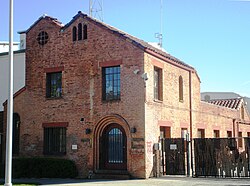The Fox Film Corporation was an American Independent film production studio formed by William Fox (1879–1952) in 1915, by combining his earlier Greater New York Film Rental Company and Box Office Attraction Company.
The Motion Picture Patents Company, founded in December 1908 and terminated in 1915 after conflicts within the industry, was a trust of all the major US film companies and local foreign-branches, the leading film distributor and the biggest supplier of raw film stock, Eastman Kodak. The MPPC ended the domination of foreign films on US screens, standardized the manner in which films were distributed and exhibited within the US, and improved the quality of US motion pictures by internal competition. It also discouraged its members' entry into feature film production, and the use of outside financing, both to its members' eventual detriment.
KCET is a secondary PBS member television station in Los Angeles, California, United States. It is owned by the Public Media Group of Southern California alongside the market's primary PBS member, Huntington Beach–licensed KOCE-TV. The two stations share studios at The Pointe in Burbank; KCET's transmitter is located atop Mount Wilson in the San Gabriel Mountains.

The Biograph Company, also known as the American Mutoscope and Biograph Company, was a motion picture company founded in 1895 and active until 1916. It was the first company in the United States devoted entirely to film production and exhibition, and for two decades was one of the most prolific, releasing over 3000 short films and 12 feature films. During the height of silent film as a medium, Biograph was the most prominent U.S. film studio and one of the most respected and influential studios worldwide, only rivaled by Germany's UFA, Sweden's Svensk Filmindustri and France's Pathé. The company was home to pioneering director D. W. Griffith and such actors as Mary Pickford, Lillian Gish, and Lionel Barrymore.

William Nicholas Selig was a vaudeville performer and pioneer of the American motion picture industry. His stage billing as Colonel Selig would be used for the rest of his career, even as he moved into film production.
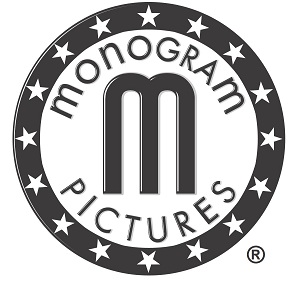
Monogram Pictures Corporation was an American film studio that produced mostly low-budget films between 1931 and 1953, when the firm completed a transition to the name Allied Artists Pictures Corporation. Monogram was among the smaller studios in the golden age of Hollywood, generally referred to collectively as Poverty Row. Lacking the financial resources to deliver the lavish sets, production values, and star power of the larger studios, Monogram sought to attract its audiences with the promise of action and adventure.

Television City, alternatively CBS Television City, is an American television studio complex located in the Fairfax District of Los Angeles, California, United States. The facilities are located at 7800 Beverly Boulevard, at the corner of Fairfax Avenue. Designed by architect William Pereira and Charles Luckman, Television City opened in 1952 as the second CBS television studio complex in Southern California, following CBS Studio Center in the Studio City section of the San Fernando Valley, which continues to house additional production facilities and the network's Los Angeles local television operations. Since 1961, Television City has served as the master control facility for CBS's west coast television network operations which were previously based at CBS Columbia Square. In 2018, CBS sold Television City to the real estate investment company Hackman Capital Partners while continuing to exclusively lease its space.

CBS Columbia Square was the home of CBS's Los Angeles radio and television operations from 1938 until 2007. Located at 6121 Sunset Boulevard in the Hollywood neighborhood of Los Angeles, California, United States, the building housed the CBS Radio Network's West Coast facilities, as well as CBS's original Los Angeles radio stations, KNX and KCBS-FM. KNXT-TV, Channel 2 moved into the complex in 1960, and the CBS's West Coast operations were based there until it moved to the larger CBS Television City in November 1952. After its purchase by CBS in 2002, KCAL-TV moved to the Square from studios adjacent to CBS's corporate sibling Paramount Pictures. Between 2004 and 2007 all of these operations moved to other facilities in the Los Angeles area.

Radford Studio Center, alternatively CBS Studio Center, is a television and film studio located in the Studio City district of Los Angeles in the San Fernando Valley. The lot has 18 sound stages from 7,000 to 25,000 square feet, 220,000 square feet (20,000 m2) of office space, and 223 dressing rooms. The triangular site is bisected by the Los Angeles River. In 2021, ViacomCBS sold Studio Center to real estate investment companies Hackman Capital Partners and Square Mile Capital Management.

The Lubin Manufacturing Company was an American motion picture production company that produced silent films from 1896 to 1916. Lubin films were distributed with a Liberty Bell trademark.
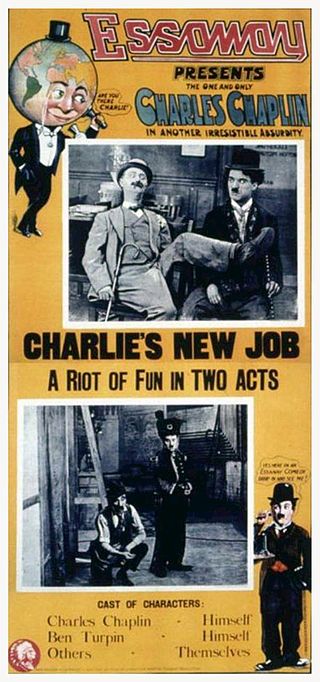
The Chicago film industry is a central hub for motion picture production and exhibition that was established before Hollywood became the undisputed capital of film making. In the early 1900s, Chicago boasted the greatest number of production companies and filmmakers. Essanay Studios founded by George K. Spoor was one of the earliest successful studios to produce movies in Chicago, employing stars such as Charlie Chaplin and Gloria Swanson. Actor and co-founder of Essanay Studios, Broncho Billy Anderson gave birth to the western genre. Early film companies such as Essanay Studios produced multiple silent films every week and rented viewing equipment to showcase the latest cinematography to the public. This rental culture gave birth to the popularity of Nickelodeons up until the Great Depression. However, due to the high demand for motion pictures during this time, a black market for films and equipment developed. The Motion Picture Patents Company, established in 1909 as a conglomerate of the major studios, sought to eliminate all illegal use of patented film equipment. As a result, independent ventures entered the film scene. Independents drove the film industry to the west to avoid legal trouble with the trust of major film companies united under the Motion Picture Patents Company. The west offered fairer weather and scenery that better accommodated film making. Not until the 1980s and early 21st century has Chicago experienced a film production revival. Blockbusters, such as Blues Brothers, Sixteen Candles, and The Dark Knight, have rejuvenated the Chicago film scene.

Sunset Gower Studios is a 14-acre (57,000 m2) television and movie studio at the corner of Sunset Boulevard and North Gower Street in the Hollywood neighborhood of Los Angeles, California, United States. Established in 1912, it continues today as Hollywood's largest independent studio and an active facility for television and film production on its twelve soundstages.

The Old Warner Brothers Studio, now known as the Sunset Bronson Studios, is a motion picture, radio and television production facility located on Sunset Boulevard in Hollywood, Los Angeles, California. The studio was the site where the first talking feature film, The Jazz Singer, was filmed in 1927.
A film studio is a major entertainment company that makes films. They may have their own privately owned studio facility or facilities; however, most firms in the entertainment industry have never owned their own studios, but have rented space from other companies. The day-to-day filming operations are generally handled by their production company subsidiary.
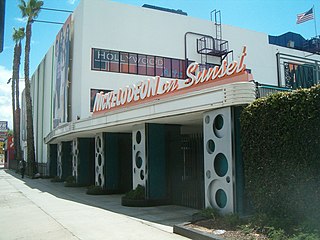
The Earl Carroll Theatre was a historic stage facility located at 6230 Sunset Boulevard in Hollywood, California. It was built by showman Earl Carroll and designed in the Streamline Moderne style by architect Gordon Kaufmann in 1938. The theatre has been known by a number of names since, including Moulin Rouge from 1953 to 1964 and the Aquarius Theater in the 1960s and 1970s. From 1997 to 2017, it was officially known as Nickelodeon on Sunset, housing the West Coast production of live-action original series produced for the Nickelodeon cable channel.
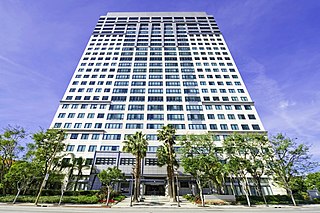
Allied Artists International, Inc. (AAI) is an American multinational mass media and entertainment corporation headquartered in Glendale, California, United States, producing and distributing motion pictures, recorded music, broadcast television, online streaming, video games, and other media products. The company is the successor to Allied Artists Pictures Corporation. In the year 2000, AAI divided its media products into three distinct wholly owned divisions, Allied Artists Film Group (AAFG), Allied Artists Music Group (AAMG) and Allied Artists Music & Video Distribution (AAMVD). Then, around 2020, AAI reorganized itself into four divisions: Allied Artists Music Group, Allied Artists Film Group, Allied Artists Films & Monogram Pictures, & Allied Artists Broadcasting & Allied Artists Music & Video Distribution. Allied Artists Pictures is known for having produced and released such historic motion pictures as Cabaret, starring Joel Grey and Liza Minnelli; Papillon, starring Dustin Hoffman and Steve McQueen; and The Betsy, starring Laurence Olivier, Tommy Lee Jones, Robert Duvall, and Katharine Ross.

The Jim Henson Company Lot, formerly A&M Studios, is a studio property located just south of the southeast corner of North La Brea Avenue and Sunset Boulevard in Hollywood. Originally established by film star Charlie Chaplin, the property served as Charlie Chaplin Studios from 1917 to 1953, which later earned the site designation as a Los Angeles Historic-Cultural Monument. After being sold by Chaplin in 1953, the property went through several changes in ownership and has served at various times as Kling Studios, the Red Skelton Studios, the shooting location for the Adventures of Superman and Perry Mason television series. From 1966 to 1999, it was the headquarters for A&M Records and the location of A&M Recording Studios. Since 2000, it has been the headquarters of The Jim Henson Company, including the Henson Soundstage and Henson Recording Studios.
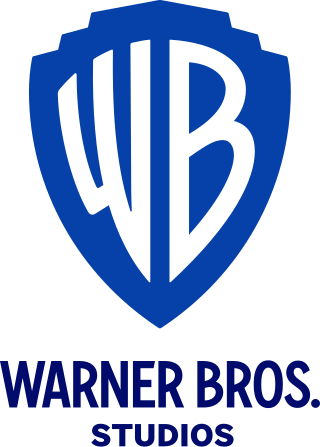
Warner Bros. Studios, Burbank, formerly known as First National Studio (1926–1929), Warner Bros.-Seven Arts Studios (1967–1970) and The Burbank Studios (1972–1990), is a major filmmaking facility owned and run by Warner Bros. Entertainment Inc. in Burbank, California. First National Pictures built the 62-acre (25 ha) studio lot in 1926 as it expanded from a film distributor to film production.
Tremlet C. Carr was an American film producer, closely associated with the low-budget filmmaking of Poverty Row. In 1931 he co-founded Monogram Pictures, which developed into one of the leading specialist producers of B pictures in Hollywood.
Scientology Network is an American television network and streaming service launched by the Church of Scientology in 2018.
